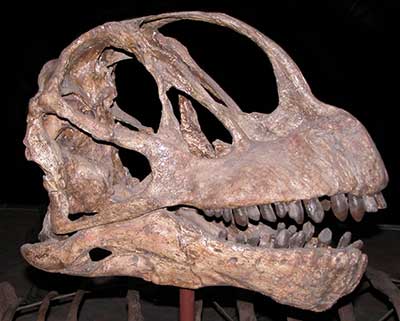Camarasaurus
(KAM-uh-ruh-SAW-rus)
| Quick Facts | |
|---|---|
| Name Meaning: | Chambered Lizard |
| Distribution: | Western United States |
| Time Period: | Late Jurassic, 150-140 Ma |
| Length: | 30-60ft (9-18m) |
| Weight: | 20 tons |
| Diet: | Tough vegetation |
| Habitat: | Plains |
| Linnaean Classification | |
| Kingdom: | Animalia |
| Phylum: | Chordata |
| Class: | Reptilia |
| Superorder: | Dinosauria |
| Order: | Saurischia |
| Suborder: | Sauropodomorpha |
| Infraorder: | Sauropoda |
| Family: | Camarasauridae |
| Genus: | Camarasaurus |
| Cladistic Classification | |
| |

History
The Camarasaurus was perhaps the most common Sauropod of the Jurassic period. Scattered remains have been found all over the western United States. The most complete skeleton was found as a juvenile Camarasaurus in the Dinosaur National Monument in Utah and is currently on display in Pittsburgh Museum. The Camarasaurus was first discovered in 1877 by Oramel W. Lucas, and later named by Edward Drinker Cope. However, these discoveries were of only a few fragments and a complete skeleton was discovered in 1925 by Charles W. Gilmore. This complete specimen was a juvenile which is why many depicted the Camarasaurus to be smaller than it actually was.Description
Its name, "chambered lizard," comes from the large cavities in the vertebrae of its backbone for weight control. The skull also contains large hollow spaces and is distinctly arched which may have contributed to the name as well. The skull was square in shape, with a blunt snout, giving it a boxed shape to its head. The distinguishing feature of the skull is the high placement of the nasal chambers. Its teeth were like chisels and were evenly distributed along the jaw. Each foot had five toes and, like many sauropods, one claw for defense. The hinds legs were longer than the front legs, as is typical of most sauropods. The largest known specimen of Camarasaurus reached an astonishing 75 ft (23 m) and weighed approximately 52 tons.Lifestyle
Fossil evidence of three Camarasaurus, two adults and one juvenile, have been discovered together suggesting that the Camarasaurus may have traveled in herds or families. Also, Camarasaurus eggs have been found in lines instead of round nests suggesting that the parent did not tend after the eggs. Scientist originally thought that dinosaurs like the Camarasaurus would have swallowed stones to help grind up the food in its stomach. However, recent evidence does not suggest any such thing. The teeth of the Camarasaurus are significantly large and strong and its diet may have consisted of tougher plant-life. It would have been able to grind up the food sufficiently so as not to need stomach stones.
ScienceViews Writer: Jason Hamilton.
Copyright © 2005-2010 Calvin & Rosanna Hamilton. All rights reserved.